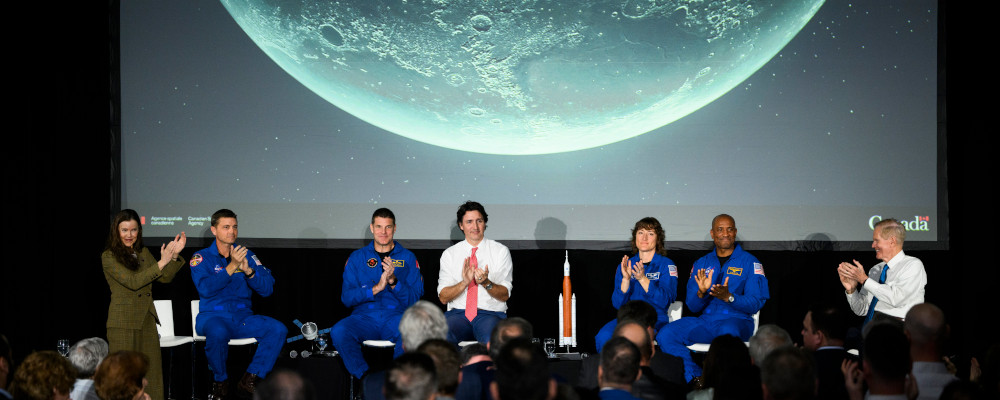India recently made history by accomplishing a lunar landing, joining the United States, China, and Russia as the only countries to have done so. India earned the additional distinction of becoming the first country to land on the Moon’s southern pole.
Aligned with Prime Minister Narendra Modi’s vision of an ascendant India asserting its place on the global stage, the Chandrayaan-3’s Moon landing has further cemented the nation’s reputation as a technological superpower. “India is now on the Moon. India has reached the south pole of the Moon. No other country has achieved that. We are witnessing history,” Modi said from South Africa while attending the BRICS summit.
It is perhaps no surprise that an ascendant India aspires to space exploration. Last year, India grew to become the world’s fifth-largest economy with a total GDP of CAD $4.5 trillion. Though placed behind its space-faring counterparts, the U.S. and China, with GDPs of CAD $34 and $24 trillion, respectively, India’s GDP surpassed each of Canada and Russia by over $2 trillion.
Russia’s recent failed attempt at landing its Luna 25 spacecraft on the Moon’s surface cost $297 million. In contrast, India’s two-week Chandrayaan-3 mission cost a mere $101 million. Notably, the Chandrayaan-3 Moon expedition cost less to launch than to produce some space movies; Interstellar and The Martian each cost over $135 million to make.
For our part, Canada is no stranger to space. Our country’s space exploration reached its heights in the early 1980s with remarkable feats, including the deployment of Canadarm 1 on the 1981 Space Shuttle Columbia mission operated by NASA. Canada also made history in 1984 by sending its first astronaut to space, Marc Garneau, aboard the NASA-operated spacecraft called STS-41-G.
Canadarm 1 and 2 still stand as two of Canada’s most notable space achievements, despite Canadarm 1 being launched over 40 years ago and Canadarm 2 more than 20 years ago. Nevertheless, Canada’s recent significant financial contributions to space exploration have continued to propel us in an important supporting role as part of NASA’s space program and the International Space Station.
The government has dedicated $2.5 billion towards these efforts, including $1.1 billion over 14 years to continue participation in the International Space Station until 2030. $76.5 million over eight years has also been allocated to support Canadian science on the NASA Lunar Gateway project, described as:
“…a vital component of NASA’s Artemis program, (which) will serve as a multi-purpose outpost orbiting the Moon that provides essential support for long-term human return to the lunar surface and serves as a staging points for deep space exploration.”
The Artemis Program, in which Canada is a core international participant, is NASA’s program to return astronauts to the Moon’s surface by 2024. Additionally, $1.2 billion over 13 years has been set aside for the development of a lunar utility vehicle, a Moon rover which is seen as “a logical next step based on technical readiness, human lunar mission needs,” which could potentially be developed on Canadian soil.
In 2020, it was announced that $150 million ($30 million annually) will be allocated over five years to establish the Canadian Space Agency’s (CSA) Lunar Exploration Accelerator Program (LEAP). LEAP is designed “to support Canada’s world-class space industry and accelerate the development of new technologies.” The CSA is preparing to use LEAP to assist in its goal of long-term exploration of the Moon and missions to Mars. LEAP will foster innovation in areas like artificial intelligence, robotics, and scientific research. Its objectives include developing technologies for future Canadian deep-space missions and enabling the Canadian space sector to conduct science experiments for lunar conditions.
The Chandrayaan-3’s relatively low cost sets a new standard in space exploration, contributing to the modern era of more attainable space flight. Canada could potentially look to allocate additional funding to the CSA, and to LEAP specifically, in order to launch its own mission to the Moon. The only holding Canada back from groundbreaking scientific developments, presumably including a lunar landing, is a lack of ambition, according to Frédéric Bouchard, the Dean of Arts and Sciences at the Université de Montréal and former chair of the Advisory Panel on the Federal Research Support System.
In a recent Hub Dialogue Bouchard expressed that when it comes to scientific research and innovation, “We’re good, but the other countries are getting better, and we’re not keeping pace. It’s not just a question of dollars, and this is very important; it’s a question of ambition…Are we ambitious enough?”

Taking a literal “moonshot” would certainly qualify as ambitious. Maybe to many Canadians, we are better off remaining a contributing supporter of NASA and a core international partner, but nothing more than that. Bouchard says this attitude is exactly the problem and why we are falling behind:
“When you talk about moonshots or when you talk about increasing innovation potential or increasing productivity…we’ve done great things, but collectively, I think we’ve been a bit complacent because we don’t see how other countries are being extremely ambitious around research innovation.”
Complacency is costly in the long run; in fact, there is substantial risk of falling behind in the rapid scientific advancements that are being made in the international space industry.
Getting ahead in the new lower-cost space flight revolution could be Canada’s ticket to international recognition as a world leader in space-related technological innovation, with all the attendant benefits, economic and otherwise, that will flow from that. And what better way to galvanize the public around this worthy endeavour than to launch our own all-Canadian mission to the Moon? Canada is a faltering middle power. Making our own mark in the stars might well change our standing here on Earth.
India may have a head-start for now with their historic lunar landing, but Canada has leading scientific expertise in many areas of space technology. Certainly we can afford the new lower costs of space exploration—remember, successful lunar launches now cost less than Hollywood space movies.
Billions of dollars have historically been allocated to Canadian space-related activities, and Canadian scientists and engineers have been crucial parts of NASA’s past success—and its future: Canadian astronaut Jeremy Hansen generated considerable buzz earlier this year when he was selected to join NASA’s Artemis II. He will become the first-ever Canadian to participate in a lunar mission. How much more inspiring would a completely Canuck-crewed mission be? Could planting a red and white maple leaf in moondust kickstart us out of our current malaise?
Canada already seems poised to have the monetary, technical, and personnel capacity to land on the Moon. In fact, it looks as if Canada has the potential to be the next global space-flight powerhouse, not just an ancillary player. That only leaves one question: do we have enough ambition to make it happen?
Recommended for You

‘Nobody cares who your daddy is’: John Whittaker and Rahim Sajan on what makes Alberta attractive to dreamers, strivers, and entrepreneurs

Seniru Ruwanpura: Canada has one of the first AI ministers in the world. Here’s a mandate for success

Paul W. Bennett: With AI taking over classrooms, it’s time to go old school again

Cam Linke: Closing Canada’s AI skills gap is key to driving our economic future




